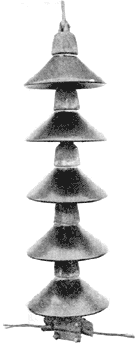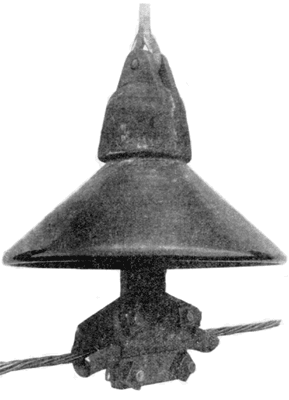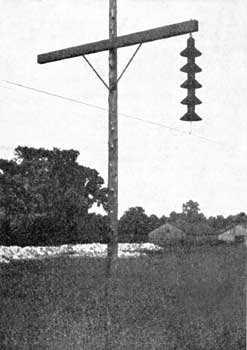[Trade Journal]
Publication: The Journal of Electricity, Power and Gas
San Francisco, CA, United States
p. 305, col. 1-2
SUSPENSION TYPE OF INSULATOR FOR HIGH
VOLTAGE TRANSMISSION.
A new and unique design of high tension insulator has been adopted for the 150-mile, 100,000-volt, transmission of the Stanislaus Electric Power Company, in California. This insulator is well shown in the accompanying illustration (fig. 2), and consists of five units, each of which is made up of two pieces of porcelain - a short inner shell and an outer flaring one. One of the great advantages of this type of insulator is that the number of units can be increased or decreased at pleasure, and in addition, it is a comparatively easy matter for a lineman to carry extra parts in event of failure of one of the units in the insulator.
 |
| Fig. 2 - New High Tension Insulator. |
It has been demonstrated by exhaustive tests that the insulator will handle 100,000 operating line voltage with a considerable factor of safety. The shells are tested individually at a potential of approximately 60,000 volts before assembling, and the unit is tested at a potential in excess of 90,000 volts for a period of five minutes. With five units in series, and with an evenly divided rain of one inch in five minutes thrown at an angle of 45 degrees, it has been found that breakdown occurs at something over 250,000 volts.
 |
| Fig. 1 - Unit of Suspended Insulator. |
It has been found that this insulator has an ultimate mechanical strength ranging from 10,000 to 12,000 pounds.
The design of this insulator was developed by Mr. J. D. E. Duncan, Electrical Engineer for Sanderson & Porter, New York City, and W. T. Goddard, Electrical Engineer for the Locke Insulator Manufacturing Co. Manufacture of the insulators is being undertaken by the Locke Insulator Manufacturing Company, Victor, N. Y., for whom Pierson, Roeding & Co. are Pacific Coast agents.
| |||
| Fig. 3 - Method of Supporting Test Insulators. |

